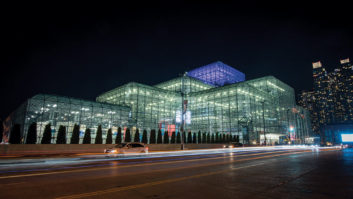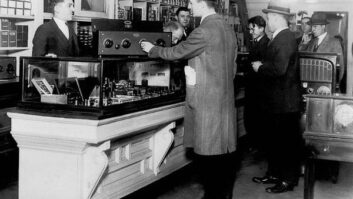The author is with the law firm Fletcher, Heald & Hildreth, on whose blog this originally appeared.
What a difference a day makes! That is, if the day in question is July 2, 2015 and you happen to be a radio broadcaster waiting for grant of a license application.
That’s because all but one of the commercial and noncommercial FM and AM licenses (both new licenses and mods of old licenses) granted on or after July 2 have included the following condition:
Grant of this license application is conditioned on continuous operations of the licensed facility for the twelve-month period following grant. Failure to do so will result in the rescission of this grant, dismissal of the license application and the forfeiture of the associated construction permit pursuant to 47 C.F.R. § 73.3598(c) unless licensee rebuts presumption that authorized facilities were temporarily constructed.
Radio licenses granted on or before July 1 don’t appear to have contained that condition.
It’s likely a good bet that the new condition will grace all AM and FM, commercial and noncommercial, licenses going forward. (Our conclusion here is based on review of all the AM and FM licenses granted between June 29 and July 21, according to CDBS. Admittedly we’re speculating, but there is no obvious reason why 21 licenses granted on or after July 2 should suddenly have all been subject to a condition that does not appear on licenses granted prior to July 1. As discussed below, the Audio Division has thus far shed no light on this at all.)
Take a close look at the language the Audio Division has added there. It says that, if the station fails to operate “continuous[ly] … for the twelve-month period following grant of the license”, the grant will be rescinded, the license application will be dismissed, and the underlying construction permit will be toast. Sure, the licensee will apparently be given some opportunity to “rebut[ ] presumption [sic] that authorized facilities were temporarily constructed” – but exactly how and when that opportunity will be provided isn’t stated.
So, for example, suppose you receive a license just before (choose one: the hurricane; the earthquake; the tornado; the blizzard; the lightning storm; the terrorist attack; the tragic plane accident; the massive unexplained county-wide power outage; etc.) occurs. That event knocks you off the air for a couple of days, maybe even a couple of weeks. You have just failed to comply with the condition, and the construction permit and license on which you relied are, under the terms of the condition, history. You can apparently try to get the breath of life breathed back into them, but really, under those circumstances would your time be better spent getting back on the air or rebutting a bogus presumption?
We’d like to explain this development, but we can’t. That’s because the Audio Division hasn’t bothered to clue us all in about what it’s doing and why. Instead, it has simply started to tack on the condition.
If this strikes you as, um, unusual, get in line.
What’s up with that?
In view of the timing, we’re guessing that this new language is part of the Division’s effort to stamp out “temporary construction”. We reported last May on a Division decision in which it frowned on the construction of less-than-permanent facilities. In particular, that decision cautioned that facilities authorized in a construction permit should be built to “endure beyond the de minimis period necessary … to file a license to cover” the permit. The Division followed that up with a second decision a few weeks later. In that latter decision, it elaborated that permittees who dismantle the facilities (or otherwise cease operation) of a station while an application for a covering license is pending must notify the Commission promptly when they do so.
Perhaps figuring that those admonitions wouldn’t stop a station from getting its license application grant and thenturning the station off and dismantling its facilities, the Division has gone a large step further. Now the constructed facilities must remain up and running not only while the license application is pending, but for a continuous 12-month period afterthe application has been granted.
This can’t be legal, can it?
As far as we can see, the legality of this move is, at best, dubious.
First, the Division’s condition effectively creates a new regulatory requirement that is inconsistent with existing rules. The rules have long recognized that some interruptions in station operation may occur from time to time. In fact, a station can be off the air for up to 30 days without asking the Commission for its permission (and up to 10 days without even having to tell the Commission). Moreover, the Communications Act provides that a station may be off-the-air for more than 11 months without facing automatic expiration of its license. The Audio Division’s new condition runs counter to those provisions. Where, exactly, does the Division get off imposing a standard that is considerably stricter than standards imposed by Congress and the full Commission? Moreover, to the extent that the Division appears to be staking out a regulatory position not previously endorsed by the Commission, it’s not clear that the Division (or the Media Bureau, for that matter) has the necessary delegated authority.
Second, if the Division has decided that it does have the authority to do what Congress and the Commission have chosen not to do, shouldn’t the Division provide at least some general heads-up about that decision? A public notice, for example, or maybe a policy statement putting all current and future radio license applicants on notice that they will be required to operate for one-year continuously, and maybe even offering something akin to an explanation. No such notice or statement has been issued. Instead, recipients of licenses granted after July 1 have found out the hard way – by reading the condition at the bottom of their licenses. That hardly seems right.
Third, the condition itself appears to be based on a plainly indefensible “presumption”. According to the D.C. Circuit, a presumption is valid only “when proof of one fact renders the existence of another fact so probable that it is sensible and timesaving to assume the truth of [the inferred] fact….” That emphatically does not describe the Division’s presumption here.
According to the Division’s new condition, a failure to operate continuously for 12 months following grant gives rise to a presumption that the facilities built were “temporarily constructed”. As we have noted in a previous post, the term “temporarily constructed” hasn’t been defined by the Division, which raises immediate questions about the validity of this presumption. But that’s by no means the only problem here. To meet the Circuit’s standard, the mere fact that a station might have failed to operate continuously for 12 months would mean that it is very probable that that station’s facilities had been temporarily constructed, so probable that it would be sensible to assume such temporary construction to be the case unless and until proven otherwise.
There is zero basis for such a conclusion.
To the contrary, in our experience the overwhelming majority of license applicants build facilities which they intend to – and do in fact – use indefinitely. That intent, however, is not a guarantee that the operation of those facilities may not be interrupted by factors beyond the licensee’s control: the full range of natural and man-made disasters, or simple mechanical malfunction, or inadvertent operator error. When such factors cause the discontinuance of operation, that does not mean that the station’s facilities were “temporarily constructed”. And yet, that is precisely the assumption on which the Division’s presumption is erroneously based.
Fourth, the condition provides for not only the rescission of the license, but also the dismissal of the license application at any time during the first 12 months following grant. Under normal circumstances, once the Division has taken action on an application, it has only 30 days (from the date of public notice of the action) to modify or set aside that action on its own motion. (The full Commission would have an additional 10 days beyond that to jump in.) So if the presumptively fatal discontinuance of operation were to occur more than 40 days after public notice of the grant of the license application, neither the Division nor the Commission would have the authority to declare, long after the fact, that the grant should be rescinded and the application dismissed. It’s not clear how that limitation squares with the Division’s condition.
On that last point, we suspect that the Division believes that, by including the condition in the license, it is able to side-step the 30-day limitation by shifting responsibility to the licensee. That is, by accepting the license with the condition, the licensee is (so the theory would go) effectively agreeing to abide by that condition notwithstanding any contrary regulatory limitations on the Division. And lest the Division be seen to be holding a gun to the licensee’s head, we expect that the Division would point to Section 1.110 of the rules. That section provides that, if a licensee isn’t happy with any condition imposed in a license which it is granted, the licensee may opt to reject the grant as made. Upon such a rejection, the Commission vacates the grant and sets the application for hearing.
In other words, the unhappy licensee isn’t forced to accept a condition it doesn’t like – but the alternative is to lose the grant and get stuck in a hearing. (Truth be told, extremely few grantees choose this course.) Whether the Division’s 12-month-continuous-operation condition is really the kind of thing for which the partial grant rule was adopted is far from clear, but that doesn’t appear to have deterred the Division.
The Division might also be thinking that folks who construct solid, permanent facilities need not worry, since they will presumably be operating continuously for the first year and, thus, the condition won’t kick in. And even if stuff happens and operation is discontinued temporarily, a couple of Polaroids of the big honking tower and fancy transmitter building should be enough to satisfy the Division’s staff that this was not a “temporary construction”.
But why should licenses issued to such folks be under any cloud at all? And let’s not forget that banks and other lenders may be very reluctant to finance construction of facilities if they know that the license covering those facilities is subject to a condition that, on its face, does not bode well for the licensee. And why should such licensees be forced to take extra steps when they happen to be forced off the air through no fault of their own?
We can all agree that, when the Commission issues a license, it expects that the licensee will in fact use that license to provide service to the public. And when stations don’t operate for extended periods of time, they are obviously not serving the public. And it may also be that the Division has encountered more non-operators than it would like. But does any of that justify an approach that seems to say that everybody who files for a radio license is presumed to be a likely non-operator?












